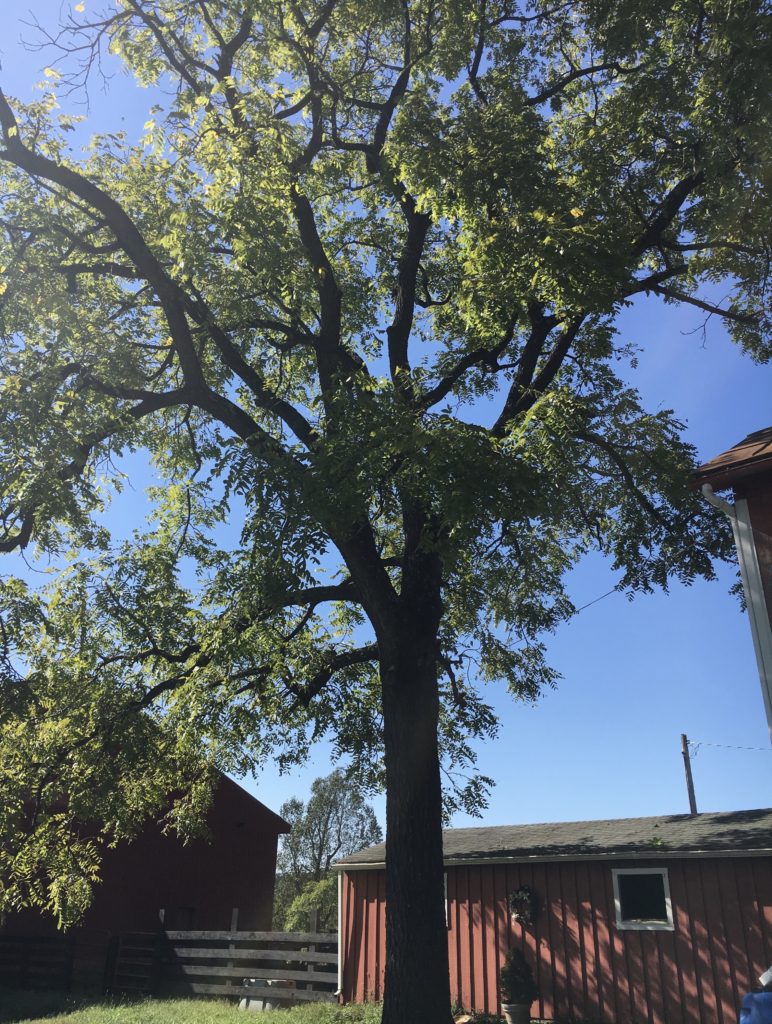Each fall there is no escaping the crunch of the smashed hulls of fallen black walnuts under our tires as we cruise back and forth in our cars along Pasturegate Lane.
For those of you who don’t know what a black walnut is, it is a generic term for the wild walnuts native to North America. Black walnuts are related to hickory nuts and butternuts. There is one main species east of the Rockies, one of which grows along Pasturegate Lane between the horse stables and the “Honeymoon Suite.” Every Autumn this tree provides a bounty of nuts that typically are left to rot on the ground.
This year I considered picking up the fallen walnuts and processing them rather than letting them go to waste. Ever eager to learn, I searched for information on how to process native black walnuts. Here is what I learned.
1. Gather the nuts soon after they fall and while the hulls are mostly green. Collect them when the husks are soft enough to easily dent with your thumb, as soon as possible to avoid mold. Be sure to wear waterproof gloves. Black walnut juice is sometimes used as a dye and will stain everything. It will not come off with any amount of scrubbing.
2. Remove the green husk. The best way to de-hull a small amount of walnuts is by hand, with a chisel and hammer to knock the hull away.
Wait. What? A chisel and hammer?
3. Now you need to clean them up. Fill a bucket with just enough water to cover the walnuts. Then stir like crazy!
The stirring will loosen up and rub off all of the remaining yellow parts from the outer husk. Dump the water, and do it again. It will take at least 5 rinses to get them clean. You may find maggots inhabiting the husks, but don’t worry, they don’t harm the nuts.
Maggots?
4. Black walnuts must be cured before they can be used, so spread them out in a single layer and let them air dry for two to four weeks. Walnuts are adequately dry when kernels are brittle.
5. Once hulled, you’re still not done. Now you must crack and shell your walnuts. Black walnuts have an extremely hard shell, so hard in fact that it is actually used in sandblasting. A standard nut cracker will not work. A splitting maul or a hammer can do the trick.
This is tedious work, people.
6. Now you need to gently remove the meats from the impossibly complex interior of the walnut. The black walnut tends to lodge itself inside the shell quite well. The best piece of equipment to do this is a stout pair of wire cutters and a nutpick. Use the wire cutters to clip the shells in key spots so larger pieces of walnut fall out.
Or if the processing of native black walnuts is too much work for you, go to Walmart where you can buy two pounds of shelled walnuts for $9.99.
And therein lies the real reason for the smashed walnuts along Pasturegate Lane. Processing the native black walnuts is too much work, especially when you can purchase processed walnuts so cheaply.
It also likely explains why there are so few workers in the garden here on the farm and why produce left in the stand by the garden often goes to waste. As one observer noted, it’s more convenient for residents to buy what they need from the grocery store than to depend on what may be growing in the garden.
How far we have come from a time not long ago when residents of the farm depended on these walnuts and the land they grew on to feed and provide for their families. This meant crops to sell at market, a garden for food, which included storing enough food to last until spring crops sprang up, animals such as cows, pigs, chickens for dairy and eggs and meat to eat. That also meant collecting food growing wild nearby, such as berries and native black walnuts, to process and store for winter consumption, never mind the time and energy required.
These days it is not necessary to depend on the land for survival. We have what farming families did not have then; money, and all the ease and luxury that comes with it. With money, we don’t have to suffer the difficult and time-consuming process of growing, gathering and processing our own food. But at what cost? Nutritionists say our ancestors who gathered and grew their own food and processed their own meats were healthier than we are today with our American diet of pre-processed food.
And we may be sacrificing more than our health. The vast majority of walnuts you buy in stores are English (also called Persian) walnuts, which are larger and easier to shell than black walnuts. But size is not the main difference between black walnuts and domesticated ones. Flavor is. The flavor of native walnuts is very rich, an almost sweetly smokey taste, they say, very unique, a wild flavor, and perhaps an acquired taste that takes some getting used to. The flavor is so strong many recipes say just half the amount of black walnuts will fully replace the flavor of regular ones, which makes it a desirable nut for baking, in ice cream or used as a topping.
So here’s the question. Why are we here if it is not to pick up walnuts, or produce from the stand (or eggs from the fridge or processed beef from the herd)? This is a timely question, and the Farmcolony board is beginning to look for answers as it considers the future of the farm in these modern times.
The number one concern of the board at present is how to generate more income to cover the costs of operating the farm. At the last board meeting, a number of income-generating ideas were put forward:
1. Opening the farm up to the film industry;
2. Promoting the farm as a wedding venue;
3. Leasing our fields;
4. Increasing farmhouse rentals;
5. Creating a microbrewery;
6. Growing grapes for winemaking;
7. Boarding more horses;
8. Increasing the cattle herd;
9. Creating a vineyard;
10. Growing hops.
Every one of these income-generating suggestions warrant further consideration.
This is an interesting time to be a resident of Farmcolony. We are at a crossroads. It is a time of change. And it is up to us to determine what that change will be. This is the time to ask ourselves, why do we choose to live at Farmcolony? (Apparently, it’s not for black walnuts.) What do we want from the farm? How can we successfully manage the farm? What is our idea of success?
Developing a plan for effectively and efficiently managing the farm into the future will require answers to these questions and much more. It will require in-depth analysis and thorough discussion among as many residents of the farm as wish to be involved in the conversation.
It will be up to us to to explore the possibilities of what Farmcolony could be. The question now is, where do we begin?


